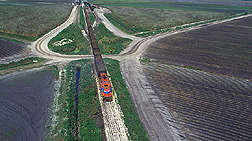A Versatile New Sugarcane for Florida
|
|
Florida is the nation’s largest producer of sugarcane and sugar, providing more than 22 percent of the nation’s domestically consumed sugar. The sugar industry has more than a $2 billion impact on Florida’s economy, providing tens of thousands of jobs statewide. It produces about 2 million tons of raw and refined sugar annually.
The Florida sugar industry’s 385,000 acres surround the southern half of Lake Okeechobee. “Proximity to the warm waters of the lake offers important protection from freezes,” says Barry Glaz, an ARS agronomist. “But not all sugarcane fields are close enough to the lake to benefit. That’s why having a variety with freeze tolerance is essential.”
A freeze can come anytime between December and late March. Once temperatures stay below 28˚F for several hours, sugarcane starts to deteriorate, and farmers must harvest their crop within 3 weeks. Having freeze tolerance can buy growers an extra 2 weeks to harvest.
Just a quarter mile east of Lake Okeechobee is the ARS Sugarcane Field Station at Canal Point, led by plant pathologist Jack Comstock. He and Glaz, geneticists Serge Edme and Scott Milligan, and soil scientist Dolen Morris have been tackling some of the biggest problems facing Florida’s sugar industry.
One of them includes finding a variety with high sugar content from October through March—essentially the entire sugarcane harvest season. The researchers’ latest advancement is the release of an increasingly popular sugarcane cultivar, called CP 89-2143.
“Finding a variety that can perform well during the period from October through March is tough,” says Comstock. “We’re pleased with CP 89-2143’s performance, so it’s no surprise that Florida cane growers are, too.”
Its acreage has increased quickly—from 1 percent of all sugarcane acres in the state in 2000 to 14.9 percent in 2004. Updated figures should show CP 89-2143 to be well over 15 percent of Florida’s total cane acreage.
These are especially strong figures, considering sugarcane is a vegetative crop that grows for 3 years before replanting. And CP 89-2143 has shown resistance to the major yield-limiting diseases of sugarcane in Florida.
After 3 years of testing at Canal Point, CP 89-2143 was tested for 5 years at nine grower farms in Palm Beach, Hendry, and Glades counties before it was released. Other cooperators include agronomist Robert Gilbert, who is with the Everglades Research and Education Center of the University of Florida’s Institute of Food and Agricultural Science, and agronomist Wayne Davidson, who is with the Florida Sugar Cane League. Retired ARS geneticists Jimmy D. Miller and Peter Tai also participated in development and selection of CP 89-2143.—By Alfredo Flores, Agricultural Research Service Information Staff.
This research is part of Plant, Microbial, and Insect Genetic Research, Genomics, and Genetic Improvement, an ARS National Program (#301) described on the World Wide Web at www.nps.ars.usda.gov.
Jack C. Comstock and Barry S. Glaz are with the USDA-ARS Sugarcane Field Station, 12990 U.S. Hwy. 441 N., Canal Point, FL 33438; phone (561) 924-5227, fax (561) 924-6109.
"A Versatile New Sugarcane for Florida" was published in the January 2006 issue of Agricultural Research magazine.







